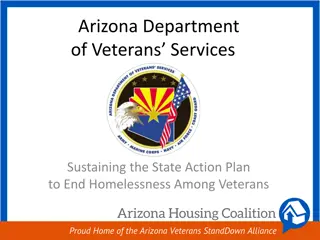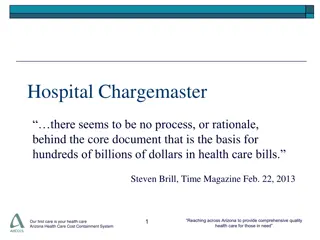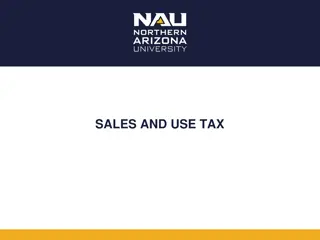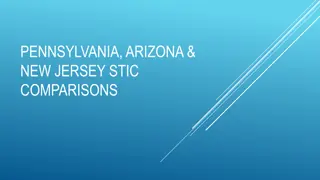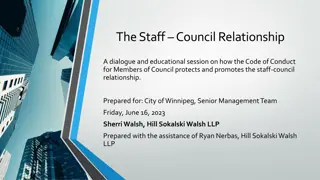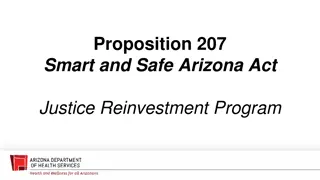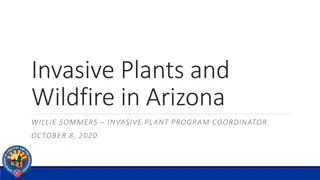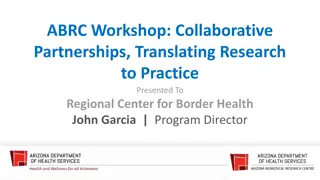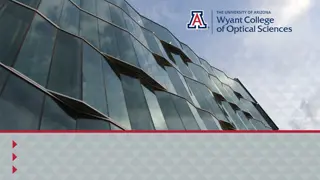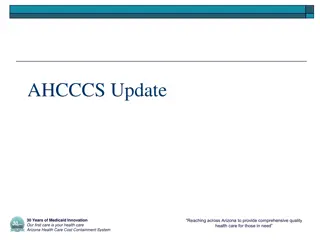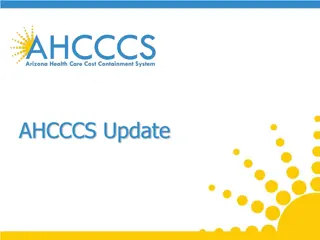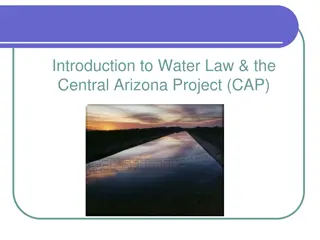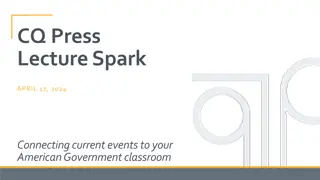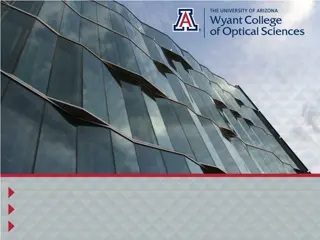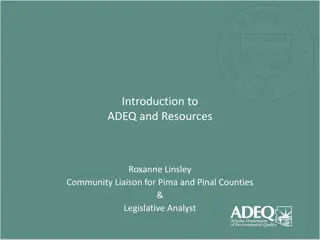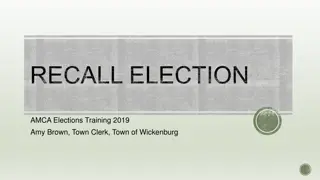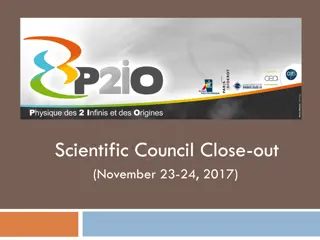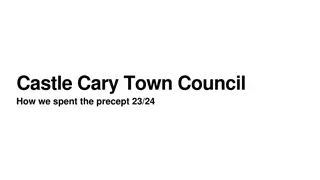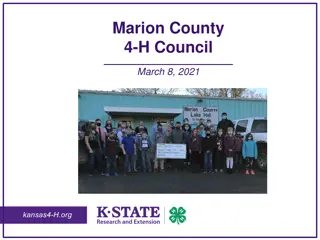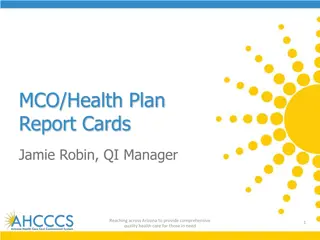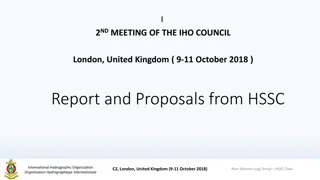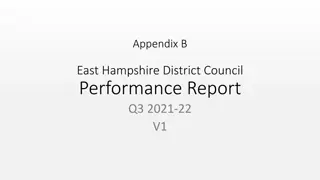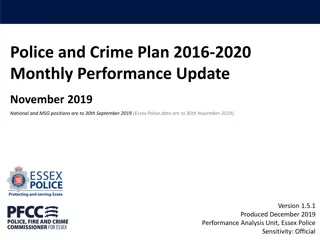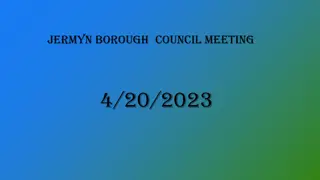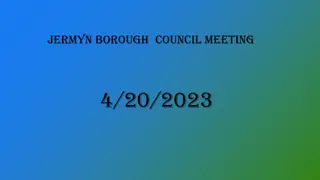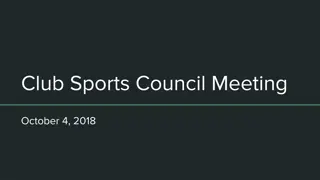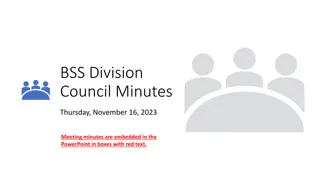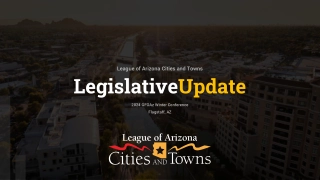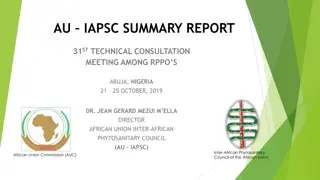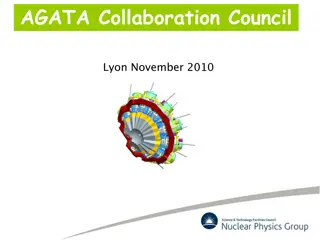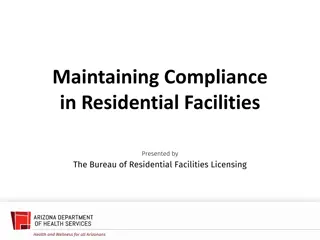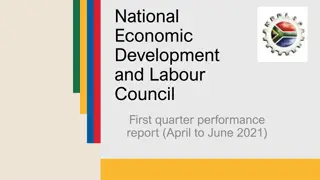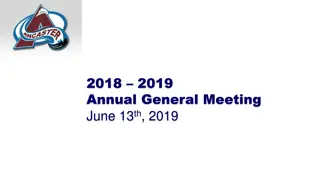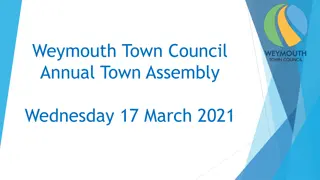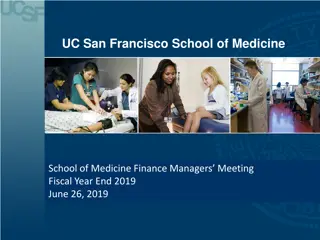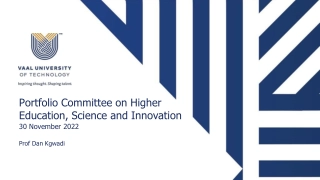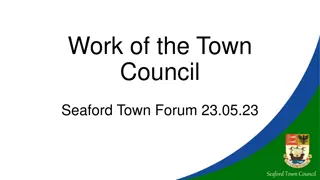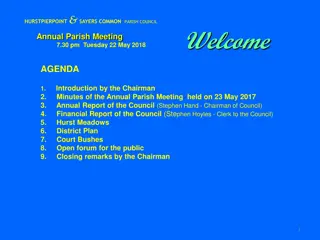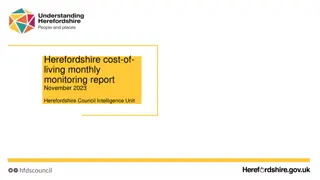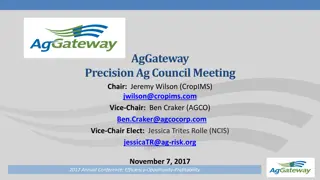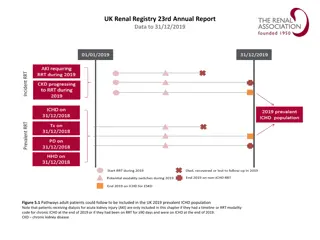Report on Arizona Faculties Council Meeting - November 21, 2019
Participants from ASU discussed topics such as measuring success of online programs, Regents' interest in student success, faculty's role in student engagement, and STEM retention presented by Yun Kang. The emphasis was on improving STEM student recruitment and retention at ASU through data analysis and programmatic approaches.
Download Presentation

Please find below an Image/Link to download the presentation.
The content on the website is provided AS IS for your information and personal use only. It may not be sold, licensed, or shared on other websites without obtaining consent from the author. Download presentation by click this link. If you encounter any issues during the download, it is possible that the publisher has removed the file from their server.
E N D
Presentation Transcript
REPORT ON NOVEMBER 21, 2019 ARIZONA FACULTIES COUNCIL (AFC) MEETING Participants from ASU: Shirley Rose, AFC Chair 2019-20; University Senate President Chris Kyselka, Secretary of the Academic Assembly; Chair of the University Senate Committee on Committees. Penny Dolin, President-elect of Poly Campus Assembly Yun Kang, President of Poly Campus Assembly Greg Stone, President-elect of Tempe Campus Assembly
SUMMARY OF ITEMS DISCUSSED Mark Denke (Associate Vice President with the Arizona Board of Regents and serves as a senior academic and student affairs officer for the Arizona University System) met with us to provide history and context for the matters that have the Regents attention. The AFC discussed the Regents' interest in additional discussion of ways of measuring success of online programs. We discussed the theme for Regents Breakfasts with Faculty 2019-20. In addition to these issues on the Board s agenda, AFC members discussed issues of mutual interest including support for our universities carbon neutrality efforts and open access policies for course learning materials.
THEME FOR REGENTS BREAKFASTS WITH FACULTY 2019-20: The regents big concern was retention and how teaching contributes to that. Excellent teaching is essential to high quality education and student success. Through their classroom interactions,teaching faculty have more contact with students than any other members of university staff. Engaging teaching is therefore the most immediate and effective means of boosting student enrollment and retention,and ensuring students have a memorable and meaningful university experience. In sum, the role of faculty in student engagement, retention, and graduation cannot be overstated. Identifying and disseminating good teaching practice is imperative for the overall success the entire university enterprise.
MATHEMATICAL MODELING OF RETENTION AND RECRUITMENT OF UNDERGRADUATE STEM PRESENTED BY YUN KANG SCIENCES AND MATHEMATICS UNIT COLLEGE OF INTEGRATED SCIENCES AND ARTS (CISA) POLYTECHNIC CAMPUS, ASU
MOTIVATIONS AND IMPORTANCE The United States faces an on-going crisis in keeping up with the demand for trained workers in science, technology, engineering and mathematics (STEM) fields (National Center for Science and Engineering Statistics 2017;National Science Board,2018). The recent research (Sithole et al., 2017) suggests that overall there is stagnation in the number of undergraduate students declaring and completing STEM degrees. ASU is a comprehensive public research university,measured not by whom it excludes,but rather by whom it includes and how they succeed. The goal is to improve freshmen persistence to a rate greater than 90% (https://president.asu.edu/asu-mission-goals). We study and identify new mechanisms and programmatic approaches designed to achieve better STEM student recruitment and retention through analysis of the available data related to existing STEM programs offered at CISA,Poly Campus. The research project s overarching goal is to determine critical factors impacting Undergraduate STEM recruitment and retention so that data-driven processes can be implemented throughout the university.
SOME CURRENT RELATED STEM PROJECTS CONDUCTED AT ASU Building Capacity: Integrating Research, Mentoring, and Industry Collaborations to Improve STEM Recruitment and Retention supported by NSF-HRD, 2019-2023 (PI: Robin Cotter and others) $1,499,985.00 Course-Based Undergraduate Research for All: Preparing the Future STEM Workforce supported by NSF-DUE-EHR, 2016-2020 (PI: Pam Marshall and others) $296,751.00 Collaborative Research: TRAIN (TRAnsfer to Interdisciplinary Natural sciences): A Community College-University Consortium to Increase Community College Student Transfer and Success supported by NSF-DUE-EHR, 2018-2022 (PI: Pam Marshall and others) $2,065,515.00 New College Environmental Health Science Scholars -A Unique Summer Program Designed to Increase Diversity in the Environmental Health Sciences supported by NIH-HSS, 2019-2024, (PI: Pam Marshall and others) $521,083.00
RESEARCH QUESTIONS OF POLY SUMMER PROJECT What is the current situation of ASU Undergraduate Recruitment and Retention? How about STEM degree? Mathematical Modeling Approach What strategies can we implement for improving STEM recruitment and retention? How can we have 20% increasing in student enrollment each year? How can we have First-year freshman retention nearing 90% goal?
Undergraduate Enrollment (Headcount) Across Three Universities http://www.azregents.edu/university-system-quick-facts Information ASU NAU UA System 2019-20 96,726 26,511 34,898 158,135 2018-19 89,898 26,639 34,547 151,084 2017-18 83,551 26,783 34,518 144,852 2016-17 79,447 26,206 34,072 139,725 2015-16 74,146 24,857 33,732 132,735 Increase from 2015-16 30.5% 6.7% 3.5% 19.1%
HTTPS://WWW.ASU.EDU/FACTS/#/FACTS/ENROLLMENT/STEM-METRO-CAMPUSHTTPS://WWW.ASU.EDU/FACTS/#/FACTS/ENROLLMENT/STEM-METRO-CAMPUS
ASU FRESHMAN RETENTION: HTTP://WWW.AZREGENTS.EDU/FRESHMAN-RETENTION 81.5% 2018 Goal: 83.5% 2025 Goal: 88.3% Retaining freshmen through their first year of college contributes to their overall academic success, as students who return for their sophomore year have a higher probability of graduating. Enhanced student services support students during key transition points throughout their freshman year.
ASU 4-YEAR GRADUATION RATE IS UP 85% SINCE 2002 HTTPS://PRESIDENT.ASU.EDU/SITES/DEFAULT/FILES/ABOR_STR ATEGIC_ENTERPRISE_PLAN_FINAL_020819.PDF Resident Freshman Cohort Graduation Rate (2002-2013) 75% 70.7% 70% 65% 66.2% 57.0% 60% 55% 50% 52.4% 49.3% 45% 6-Year Rate 40% 35% 5-Year Rate 28.4% 30% 4-Year Rate 25% '02 '03 '04 '05 '06 '07 '08 '09 '10 '11 '12 '13 Cohort Entry Year 11
MATHEMATICAL MODEL-DIAGRAM recruitment recruitment recruitment r3 r2 r4 Retention rate Sophomore C2 Retention rate Junior C3 Retention rate Freshman C1 Senior recruitment C4 r1 r12 r23 r34 rg GraduationG THIS MODEL COULD EXTEND TO MORE THAN FOUR YEARS
OUR MODEL INDICATES Graduation from The First-Year Freshmen ? ? + 1 = ?g? + 1 r34? r23? 1 r12? 2 r1(t-3) Graduation from The Second-Year Transfer ? ? + 1 = ?g? + 1 r34? r23? 1 r2(t-2) Graduation from The Third-Year Transfer ? ? + 1 = ?g? + 1 r34? r3(t-1) Graduation from The Fourth-Year Transfer ? ? + 1 = ?g? + 1 r4(t)
SOME IMPLICATIONS It is important that we spend enough attention on recruitment and retentions of the first year freshmen ?g? + 1 r34? r23? 1 r12? 2 r1(t 3) The last two years retention rates are important ?g? + 1 r34? And we should also focus on transfer students in the second, third, fourth year AZTransfer develops and maintains web services and other resources directly related to https://public.azregents.edu/News%20Clips%20Docs/AzTransfer_Report.pdf operating the Arizona Transfer System and promoting transfer opportunities and programs. https://public.azregents.edu/News%20Clips%20Docs/AzTransfer_Report.pdf
TRANSFER FROM ARIZONA COMMUNITY COLLEGES HTTPS://PUBLIC.AZREGENTS.EDU/NEWS%20CLIPS%20DOCS/ AZTRANSFER_REPORT.PDF
Community College Transfers Awarded a Bachelor's Degree http://www.azregents.edu/universtiy-system-quick-facts Information ASU NAU UA System 2017-18 4,602 1,941 1,119 7,662 2016-17 4,515 2,083 1,235 7,833 2015-16 4,629 1,752 1,165 7,546 2014-15 4,611 1,818 1,141 7,570 2013-14 4,419 1,796 1,181 7,396 Change from 2013-14 4.1% 8% -5.3% 3.6%
ONE APPLICATION OF OUR MODEL President Crow s Annual Growth Rate 20% Math Expression is ri(t+1)=(1+20%) ri(t) The retention rate is near 90%, say, rii+1(t)=90% Then we should expect the graduate rate in 4-year being 72.9% at year t, then the next year being 87.48% with 14.58% increasing each year, IDEALY.
TAKEN-HOME MESSAGES: ASU has been doing great in both undergraduate enrollment and retention rates! We have been successful in implementing many Freshman Retention Programs such as First-Year Success (FYS) center, ME3, Adaptive Learning (http://www.azregents.edu/sites/default/files/reports/Special-Limited- Report-on-Freshman-Retention.pdf) The last two years retention rates are important In addition to the first year freshmen, we should also focus on transfer students in the second, third, fourth year There is huge research/education funding opportunities for STEM programs
ONGOING EFFORTS AND PLAN Note that there are many NSF/NIH grants on retention and recruitment of STEM programs between PHX area and its local community colleges. Poly ASU shares around 600 acres (2.4 km2) at Power and Williams Field roads with Chandler Gilbert Community College,Mesa Community College,Embry-Riddle Aeronautical University, a United States Air Force research laboratory, Arizona State University Preparatory Academy for PK-8,Polytechnic High School, and the Silvestre Herrera Army Reserve Center. These entities make up what is known as the Williams Campus. This provide excellent opportunity for us to apply for STEM grants in the east valley to connect middle/high school to community colleges to ASU poly STEM degrees.
THANK YOU AND ACKNOWLEDGMENTS The Provost Office for supporting this summer project Senate President: Shirley Rose (Comments and Editing on the proposal and presentation) Past-Poly President: Nancy Cooke (Comments and Discussions on the proposal) CISA Dean: Duane Roen (connecting with varied resources for this project) Undergraduate Research Assistant: Tanner Dolby Dr. Pam Marshall; Dr. Robin CISA and ASU Staff: Jamie Eggerling (Assistant Director Academic Services) Therese Aguayo (Executive Director of Academic Advising) Jared Vibbert (Assistant to the Dean) Julie Lim (Student Engagement Coordinator Sr.) Dr. Kevin Correa (Director of First-Year Success Center) Gerald West (Asst Director, Recruiting, Outreach & Engagement) Sarang Deshpande (Data Analysis)
REFERENCES https://public.azregents.edu/Academic%20Affairs%20and%20Educational%20Attainment/2019-3-28-AAEA-Committee-Book-FINAL.pdf https://president.asu.edu/sites/default/files/abor_strategic_enterprise_plan_final_020819.pdf https://public.azregents.edu/News%20Clips%20Docs/AzTransfer_Report.pdf http://www.azregents.edu/sites/default/files/reports/Special-Limited-Report-on-Freshman-Retention.pdf https://www.asu.edu/facts/#/ National Center for Science and Engineering Statistics. (2017). Women, Minorities, and Persons with Disabilities in Science and Engineering. Retrieved from https://www.nsf.gov/statistics/2017/nsf17310/ National Science Board. (2018). Science & Engineering Indicators 2018. Retrieved from https://www.nsf.gov/statistics/2018/nsb20181/ Chang J-M, Kwon C, Buonora P. and Stevens L, 2015. Strategies to Recruit and Retain Students in Physical Science and Mathematics on a Diverse College Campus, Journal of College Science Teaching 45(3):14-22. Snyder J and Cudney E. A., 2017. Retention Models for STEM Majors and Alignment to Community Colleges: A Review of the Literature. Journal of STEM Education, 18(3). Sithole A., Chiyaka E. T., McCarthy P., Mupinga D. M., Bucklein B. K., and Kibirige J. (2017). Student Attraction, Persistence and Retention in STEM Programs: Successes and Continuing Challenges. Higher Education Studies, 7, 46 59. doi:10.5539/hes.v7n1p46


